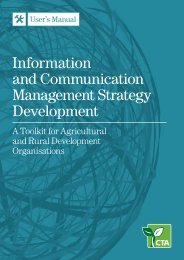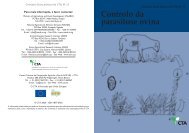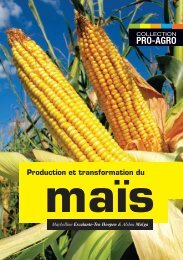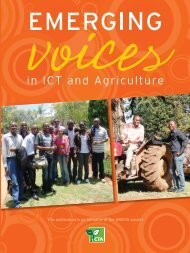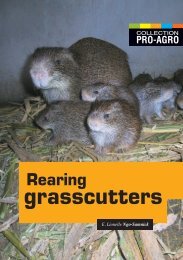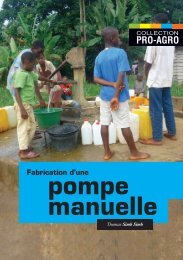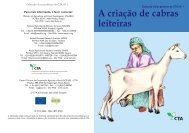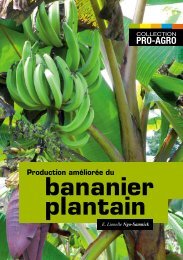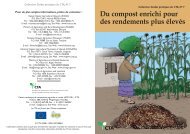Policy framework for Pastoralism in Africa
Policy framework for Pastoralism in Africa
Policy framework for Pastoralism in Africa
- No tags were found...
Create successful ePaper yourself
Turn your PDF publications into a flip-book with our unique Google optimized e-Paper software.
and Burundi) have multi-faceted development challenges. For example, levels of poverty rangefrom 57 percent <strong>in</strong> Rwanda to 71% <strong>in</strong> the DRC; <strong>in</strong> DRC the level of poverty among pastoral communities(80 percent) is higher than the national average. In Burundi the livestock sector contributes14 percent to national GDP and 29 percent to agricultural GDP.2.3.4 Eastern <strong>Africa</strong>The multipurpose socioeconomic and cultural features of pastoralism are better exploited <strong>in</strong> East<strong>Africa</strong> compared to other regions. The region <strong>in</strong>cludes Sudan and Somalia which are major livestockexporters to the Gulf States, whereas Ethiopia has a substantial <strong>in</strong><strong>for</strong>mal export trade throughSomalia, and a grow<strong>in</strong>g <strong>for</strong>mal export trade to the Gulf States, Egypt, Sudan and other countries.Most of the livestock enter<strong>in</strong>g these markets are sourced from pastoral areas. Livestock exportfacilities along the northern Somali coast and Djibouti cont<strong>in</strong>ue to grow, often with private sector<strong>in</strong>vestment. Eastern <strong>Africa</strong> is also characterized by exploitation of pastoral areas <strong>for</strong> wildlife conservationand tourism, especially <strong>in</strong> Kenya and Tanzania, although the extent to which revenuesbenefit pastoralists is unclear. The region also has substantial oil, m<strong>in</strong>eral and natural gas reserves<strong>in</strong> pastoral areas.In Sudan, the pastoral-dom<strong>in</strong>ated livestock sector contributes 80 percent of the agricultural GDP.In Ethiopia the livestock-dependant leather <strong>in</strong>dustry is the second largest source of <strong>for</strong>eign currencyafter coffee. Recent reviews of the livestock sector <strong>in</strong> Ethiopia conducted by government <strong>in</strong>dicatea substantial under-valu<strong>in</strong>g of the sector. In Uganda, pastoralist and small livestock producerscontribute the fourth largest share of <strong>for</strong>eign currency earn<strong>in</strong>gs. Kenya and Tanzania have vast aridlands occupied by pastoralists, who supply the substantial domestic meat markets.2.3.5 Southern <strong>Africa</strong>In South <strong>Africa</strong> pastoralism account <strong>for</strong> about 60 per cent of the national cattle herd, where thelivestock sector, <strong>in</strong>clud<strong>in</strong>g pastoralism, is an important meat export market <strong>for</strong> neighbour<strong>in</strong>gNamibia. In Namibia pastoral-dom<strong>in</strong>ated livestock sector contributes 3 per cent of GDP and 28percent of the agricultural GDP. Namibian pastoralists hold 80 per cent of the national cattle herd,which contribute about one-third of <strong>in</strong>come <strong>in</strong> traditional households. <strong>Pastoralism</strong> seems to playa less important role <strong>in</strong> the economies of Lesotho, Mozambique, Zimbabwe and Angola.2.4 Social and cultural contextsThere are approximately 268 million <strong>Africa</strong>n pastoralists and there<strong>for</strong>e, pastoral culture is a corepart of <strong>Africa</strong>’s culture, history and heritage. In common with other peoples <strong>in</strong> <strong>Africa</strong>, pastoralgroups have their own languages and traditions, a rich body of oral and written stories and poetry,and songs and music.The livestock and natural resource management practices used by pastoralists require well organizedcollective action, especially <strong>in</strong> the harsh environments <strong>in</strong> which they live. Pastoralists organizethemselves to split herds and move animals to distant graz<strong>in</strong>g areas, to control access to communalgraz<strong>in</strong>g areas, to manage the water<strong>in</strong>g of livestock, and to provide security. Partly <strong>for</strong> these reasons,pastoralists have very strong social organizations and leadership. In pastoral ecosystems of theMediterranean, Saharan and sub-Saharan zone, Islam is a common religion and the rules of access18 <strong>Policy</strong> <strong>framework</strong> <strong>for</strong> <strong>Pastoralism</strong> <strong>in</strong> <strong>Africa</strong>




